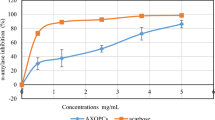Abstract
The enzymatic digestibility of parent γ-cyclodextrin by human saliva α-amylase was investigated aiming at the determination of lifespan of intact macro ring. It was found that the ring-opening reaction was the slowest step of the γ-cyclodextrin degradation process. The reaction products were mainly maltose and malto-triose, while no higher malto-oligomers were detected. The enzymatic degradation of γ-cyclodextrin reduces the possibility of influencing bioavailability of nutritional lipophiles or drug actives co-administered with γ-cyclodextrin as an excipient or additive. Though there are numerous papers on the ring opening of cyclodextrins by amylases and the same capability of the human α-amylase is expected now we prove this activity. The hydrolysis reaction was followed by direct measurement of the resulting maltose and malto-triose, for the first time.



Similar content being viewed by others
References
Szejtli, J.: Introduction and general overview of cyclodextrin chemistry. Chem. Rev. 98, 1743–1753 (1998)
Szejtli, J.: Past, present, and future of cyclodextrin research. Pure. Appl. Chem. 76, 1825–1845 (2004)
Szente, L., Harangi, J., Greiner, M., Mandel, F.: Cyclodextrins found in enzyme- and heat-processed starch-containing foods. Chem. Biodiv. 3, 1004–1014 (2006)
Marshall, J.J., Miwa, I.: Kinetic difference between hydrolyses of gamma-cyclodextrin by human salivary and pancreatic alpha-amylases. Biochim. Biophys. Acta. 661(1), 142–147 (1981)
Allerge, M., Deratani, A.: Cyclodextrin uses: from concept to industrial reality. Agro. Food Ind. Hi-Tech. 5(1), 9–17 (1994)
Munro, I.C., Newberne, P.M., Young, V.R., Bar, A.: Safety assessment of γ-cyclodextrin. Regul. Toxicol. Pharmacol. 39, S3–S13 (2004)
Kondo, H., Nakatani, H., Hiromi, K.: In vitro action of human and porcine α-amylases on cyclomalto-oligosaccharides. Carbohydr. Res. 204, 207–213 (1990)
DeBie, A.T., van Ommen, B., Bar, A.: Disposition of 14C-gamma-cyclodextrin in germ-free and conventional rats. Regul. Toxicol. Pharmacol. 27(2), 150–158 (1998)
Jodál, I., Kandra, L., Harangi, J., Nánási, P., Szejtli, J.: Hydrolysis of cyclodextrin by Aspergillus oryzae α-amylase. Starch 36, 140–143 (1984)
Jodál, I., Harangi, J., Lipták, A., Nánási, P., Szejtli, J.: Degradation of Cyclodextrins with Aspergilus-oryzae α-amylase. Acta Biochim. Biophys. Hung. 17(1–2), 102-102 (1982)
Kandra, L., Gyémánt, G.: Examination of the active sites of human salivary α-amylase (HSA). Carbohydr. Res. 329, 579–585 (2000)
Kandra, L., Gyémánt, G., Remenyik, J., Hovánszki, G., Lipták, A.: Action pattern and subsite mapping of Bacillus licheniformis α-amylase (BLA) with modified maltooligosaccharide substrates. FEBS. Lett. 518, 79–82 (2002)
Kandra, L., Gyémánt, G., Lipták, A.: Action pattern of α-amylases on modified maltooligosaccharides. Biologia 57(suppl 11), 171–180 (2002)
Gyémánt, G., Hovánszky, G., Kandra, L.: Subsite mapping of the binding region of alpha-amylases with a computer program. Eur. J. Biochem. FEBS. 269, 5157–5162 (2002)
Robyt, J.F.: Inhibition, activation, and stabilization of α-amylase family enzymes. Biologia 60(suppl 16), 17–26 (2005)
Asp, M.L., Hertzler, S.R., Chow, J., Wolf, B.W.: Gamma-cyclodextrin lowers postprandial glycemia and insulinemia without carbohydrate malabsorption in healthy adults. J. Am. Coll. Nutr. 25(1), 49–55 (2006)
Buedenbender, S., Schulz, G.E.: Structural base for enzymatic cyclodextrin hydrolysis. J. Mol. Biol. 385, 606–617 (2009)
Mótyán, J.A., Gyémánt, G., Harangi, J., Bagossi, P.: Computer-aided subsite mapping of α-amylases. Carbohydr. Res. 346, 410–415 (2011)
Jodál, I., Harangi, J., Nánási, P., Szejtli, J.: Preparation of maltooligomers by controlled enzymatic hydrolysis. Acta. Biochim. Biophys. Hung. 19(1–2), 141-141 (1984)
Author information
Authors and Affiliations
Corresponding author
Rights and permissions
About this article
Cite this article
Harangi, J., Béke, G., Harangi, M. et al. The digestable parent cyclodextrin. J Incl Phenom Macrocycl Chem 73, 335–339 (2012). https://doi.org/10.1007/s10847-011-0061-0
Received:
Accepted:
Published:
Issue Date:
DOI: https://doi.org/10.1007/s10847-011-0061-0




